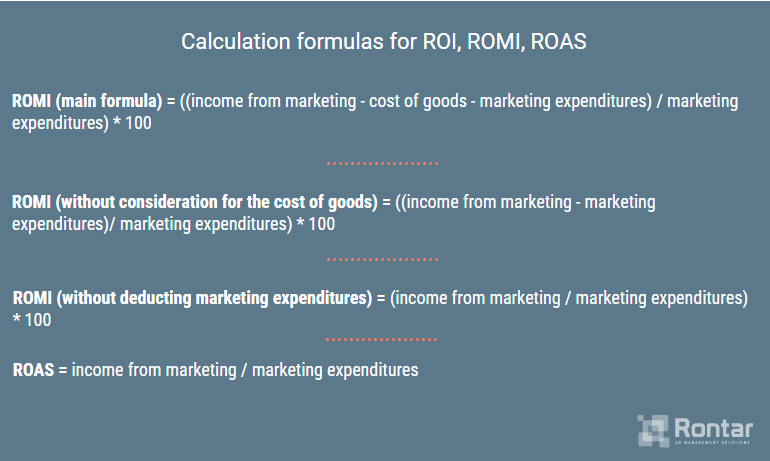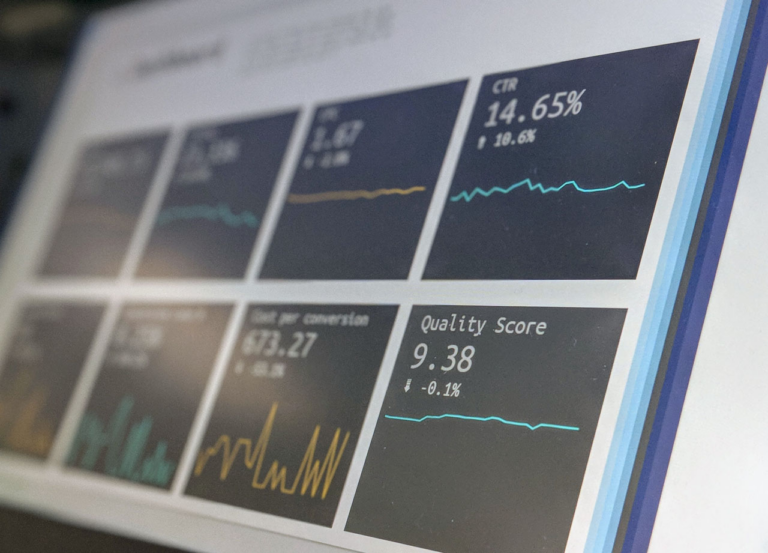Evaluating the effectiveness of advertising campaigns: ROMI, ROI and ROAS

There are many metrics which help evaluate the effectiveness of advertising campaigns. The three most used metrics are ROI, ROAS and ROMI. Marketers often confuse ROI and ROMI, ROI and ROAS, therefore let’s look with deeper detail at what the difference is and which metric is best used in order to evaluate online advertising campaigns.
ROMI (Return On Marketing Investment)
ROMI is an indication of return on investment in marketing. As a percentage ratio it demonstrates profitability or waste of a concrete sum of invested money. It is calculated with the following formula:
ROMI = ((income from marketing – cost of goods – marketing expenditures) / marketing expenditures) * 100.
If ROMI is less than 100%, then marketing investments were wasteful, if its more than 100%, they were profitable.
ROMI is an indication of return on investment in marketing. As a percentage ratio it demonstrates profitability or waste of a concrete sum of invested money. Click To TweetFor example, we need to understand the effectiveness of a retargeting campaign. Monthly spending was $2,400, and the campaign generated sales of $31,200. Taking into account the cost of goods sold totals $24,960, the effectiveness of the advertising campaign is calculated with the formula:
ROMI = ((31,200 – 24,960 – 2,400) / 2,400) * 100 = 160%
In this case the ROMI equals to 160% for the retargeting campaign. This means that the campaign is profitable. The campaign, therefore, generated $1.60 of income for every dollar spent on marketing.
Different approaches to calculating ROMI
Sometimes formulas to calculate ROMI look different from ones that we provided. Let’s look at the most common variations.
ROMI without consideration for cost of goods
Often one can find the following versions of the ROMI calculation:
ROMI (without consideration for the cost of goods) = ((income from marketing – marketing expenditures)/ marketing expenditures) * 100
In this formula the cost of goods is not considered. Meaning that instead of considering generated profit, we consider generated income.
As a rule this version of calculating ROMI is used by advertising platforms that do not have access to the cost of goods. If an advertising system has statistics such as ROMI (or ROI) – know that this number is calculated by the above formula. The given number will drastically differ from ROMI, which is calculated considering cost of goods.
If we were to use that formula for evaluating the effectiveness of our retargeting campaign, then we would get the following results:
ROMI = ((31,200 – 2,400) / 2,400) * 100 = 1,200%
ROMI without considering marketing costs
It’s also possible to find a ROMI formula that does not deduct marketing expenditures:
ROMI (without deducting marketing expenditures) = (income from marketing / marketing expenditures) * 100
Just like the case of the ROMI formula without the cost of goods the use of the above formula is typical for advertising platforms.
Let’s calculate ROMI using such formula for our retargeting campaign:
ROMI = (31,200 / 2,400) * 100 = 1,300%
ROI (Return On Investment)
There is no difference between calculating ROI and ROMI. Definition-wise, ROI is more of a general term while ROMI is a term used solely in marketing.
Oftentimes when marketers use the term ROI in regards to the marketing channel, they are actually talking about ROMI.
ROAS (Return on Ad Spend)
ROAS is an indicator of return on investment in advertising. It is mostly similar to ROMI and is calculated using the following formula:
ROAS = income from marketing / marketing expenditures
Such metric is very similar to the ROMI formula without deducting the cost of goods and advertising expenditures.
Such metrics can be used for comparing different marketing channels. For example Google Analytics uses ROAS to evaluate launched Google AdWords campaigns. The retargeting platform Rontar evaluates campaigns using an analog of ROAS, namely the metric ROMI without deducting the cost of goods and advertising costs.
Advertising channels should not be evaluated strictly on the basis of ROAS. The metric does not take into consideration the cost of goods, therefore it doesn’t fully reflect the effectiveness of the advertising channel.
Advertising channels should not be evaluated strictly on the basis of ROAS. The metric does not take into consideration the cost of goods, therefore it doesn’t fully reflect the effectiveness of the advertising channel. Click To TweetLets return to our example with the retargeting campaign and calculate ROAS using the same data:
ROAS = 31,200 / 2,400 = 13
For each dollar spent we gained $13, which at a first glance seems like a lot, although from the initial calculation we know that ROMI is only 160%.
Which metric is best to use to evaluate advertising campaigns

When choosing between ROMI and ROAS, always opt for ROMI, specifically the formula which includes the cost of goods sold. Unlike ROAS, ROMI can give you a better understanding of when or not the investments are paying off, and, if they are, by how much.






